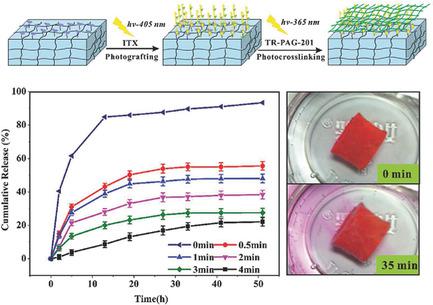当前位置:
X-MOL 学术
›
Macromol. Rapid Commun.
›
论文详情
Our official English website, www.x-mol.net, welcomes your
feedback! (Note: you will need to create a separate account there.)
Surface‐Selective Grafting of Crosslinking Layers on Hydrogel Surfaces via Two Different Mechanisms of Photopolymerization for Site‐Controllable Release
Macromolecular Rapid Communications ( IF 4.2 ) Pub Date : 2018-05-28 , DOI: 10.1002/marc.201800144 Jiaojiao Zhang 1 , Jun Nie 1, 2 , Xiaoqun Zhu 1, 2
Macromolecular Rapid Communications ( IF 4.2 ) Pub Date : 2018-05-28 , DOI: 10.1002/marc.201800144 Jiaojiao Zhang 1 , Jun Nie 1, 2 , Xiaoqun Zhu 1, 2
Affiliation

|
This study reports an effective method for controlling substance‐release sites of hydrogel. Glycidyl methacrylate, which contains two functional groups, namely, double‐bond acrylate and epoxide, is photografted on a hydrogel surface through hydrogen abstraction photopolymerization due to the existence of a hydrogen donor, such as an amine, in the hydrogel matrix. The remaining epoxide group crosslinks the polymer chain of polyglycidyl methacrylate. Substance release of hydrogel is changed due to the altered surface texture of hydrogel. Rate and site‐controlled substance release are achieved by controlling the thickness and site of surface grafting and the extent of epoxide ring opening. This study may provide a novel method for achieving hydrogel function or modified performance of other biomaterials to meet biological activity requirements.
中文翻译:

水凝胶表面交联层的表面选择性接枝通过两种不同的光聚合机理进行位控释放
这项研究报告了控制水凝胶物质释放部位的有效方法。甲基丙烯酸缩水甘油酯含有两个官能团,即丙烯酸双键和环氧化物,由于在水凝胶基质中存在氢供体(例如胺),因此通过夺氢光聚合作用将其光接枝在水凝胶表面。剩余的环氧基团使聚甲基丙烯酸缩水甘油酯的聚合物链交联。水凝胶的物质释放由于水凝胶的表面质地的改变而改变。通过控制表面接枝的厚度和位置以及环氧化物开环的程度,可以实现速率和位置控制的物质释放。这项研究可能提供一种实现其他生物材料的水凝胶功能或改性性能以满足生物活性要求的新颖方法。
更新日期:2018-05-28
中文翻译:

水凝胶表面交联层的表面选择性接枝通过两种不同的光聚合机理进行位控释放
这项研究报告了控制水凝胶物质释放部位的有效方法。甲基丙烯酸缩水甘油酯含有两个官能团,即丙烯酸双键和环氧化物,由于在水凝胶基质中存在氢供体(例如胺),因此通过夺氢光聚合作用将其光接枝在水凝胶表面。剩余的环氧基团使聚甲基丙烯酸缩水甘油酯的聚合物链交联。水凝胶的物质释放由于水凝胶的表面质地的改变而改变。通过控制表面接枝的厚度和位置以及环氧化物开环的程度,可以实现速率和位置控制的物质释放。这项研究可能提供一种实现其他生物材料的水凝胶功能或改性性能以满足生物活性要求的新颖方法。











































 京公网安备 11010802027423号
京公网安备 11010802027423号